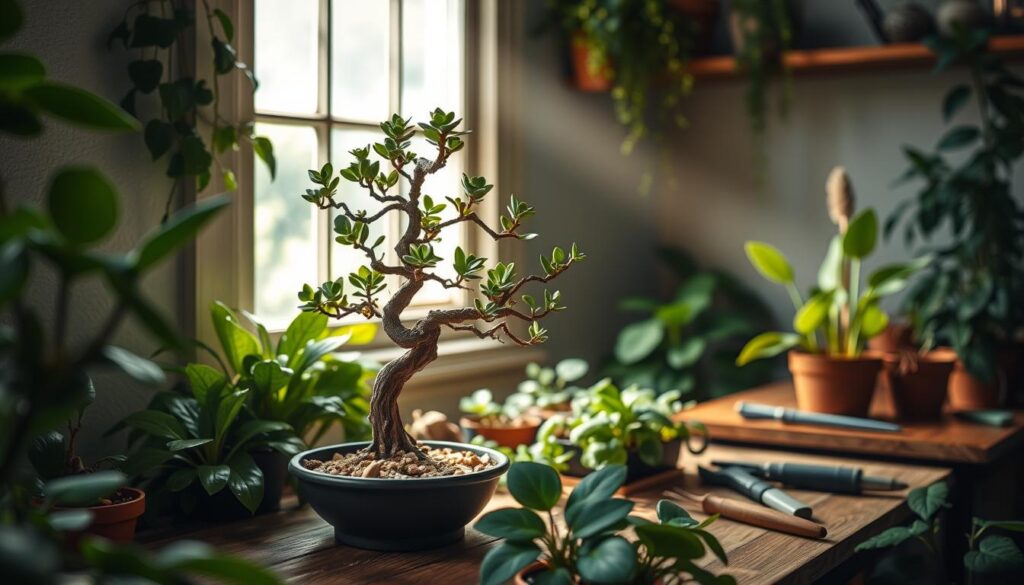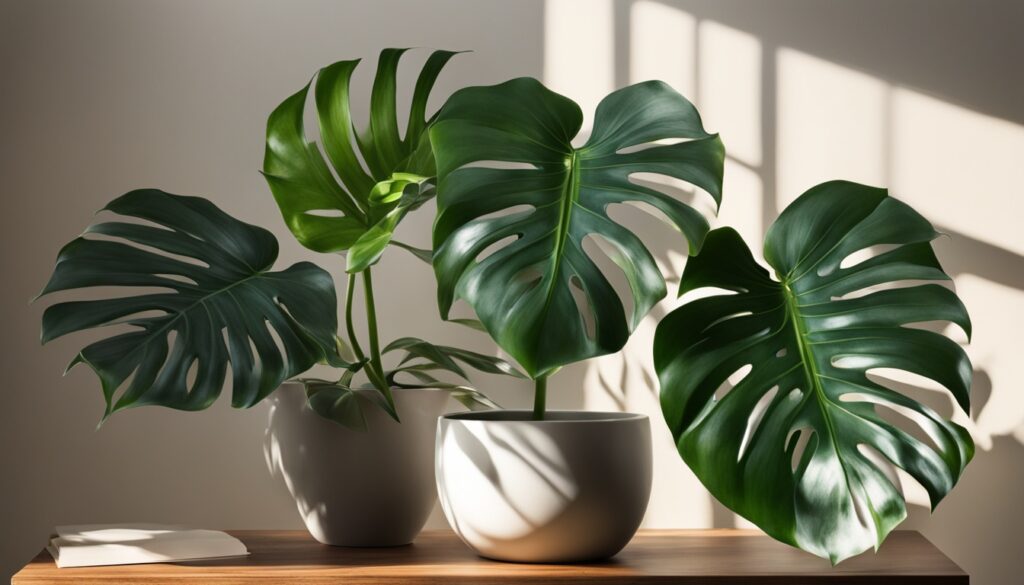Have you thought about adding bonsai to your indoor garden? Bonsai tree succulents mix ancient Japanese art with the easy care of drought-resistant plants. They turn any small space into a peaceful oasis.
These plants are a unique and eye-catching addition to any indoor gardening setup. But what makes them so special, and how can you grow them at home? Let’s explore the world of bonsai tree succulents and learn their secrets.
Key Takeaways
- Bonsai tree succulents combine the ancient art of bonsai with the low-maintenance characteristics of drought-resistant plants.
- These miniature trees offer a unique and visually stunning addition to indoor gardens, bringing the beauty of nature into small spaces.
- Proper care, including pruning, shaping, and providing the right growing conditions, is essential for maintaining the health and artistic form of bonsai tree succulents.
- Bonsai tree succulents are versatile and adaptable, making them a popular choice for indoor gardening enthusiasts.
- Exploring the world of bonsai tree succulents can be a rewarding and captivating experience for both novice and experienced indoor gardeners.
Understanding the Art of Bonsai Tree Succulents
Bonsai, an ancient Japanese art, has fascinated gardeners globally. It now combines with succulents, creating a new indoor gardening trend. This mix appeals to potted plant hobbyists who want easy-to-care-for, eye-catching plants.
Origins and Cultural Significance
Bonsai started in China and was perfected in Japan. It shows a balance between nature and human creativity. Adding succulents to bonsai brings a new twist, blending tranquility with resilience.
The Fusion of Two Plant Worlds
Succulents add variety to bonsai, with their shapes, colors, and growth. These tiny tree growing plants thrive in tough conditions. They offer a creative outlet for bonsai lovers, from jade plants to crown of thorns.
Modern Adaptations in Indoor Gardening
More people are into bonsai tree cultivation and succulent care. Bonsai tree succulents are popular for their ease and beauty. They’re perfect for city living and potted plant hobbyists wanting a green touch without much work.
“The fusion of bonsai techniques and succulent species has given rise to a modern, low-maintenance approach to indoor gardening.”
Essential Components of a Bonsai Tree Succulent Setup
To grow a bonsai tree succulent, you need a special setup. Start with a shallow container that drains well. This lets the roots grow strong. The soil mix must match the bonsai succulent’s needs for it to stay healthy.
Tools like pruning shears and wire are key for shaping. They help keep the bonsai looking great. Decorative rocks or moss add beauty to the setup.
This mix of function and beauty is what makes a bonsai succulent stand out. It lets these small wonders thrive in your home.
Selecting the Ideal Container
The right container is crucial for a bonsai tree succulent. It should be shallow and drain well. Materials like ceramic, wood, or stone are best because they let roots breathe.
The container’s size and shape should match the plant. This creates a balanced look.
Crafting the Perfect Soil Mixture
The soil mix for bonsai tree succulents is a special blend. It includes Akadama, pumice, lava rock, and fine gravel. This mix helps with drainage, water, and air for the roots.
The soil’s pH should be between 6.5 and 7.5. This is best for most succulents.
| Soil Component | Function | Recommended Ratio |
|---|---|---|
| Akadama | Provides water retention and nutrient absorption | 50% for deciduous, 33% for conifers |
| Pumice | Enhances water retention and root development | 25% for deciduous, 33% for conifers |
| Lava Rock | Improves drainage and aeration | 25% for deciduous, 33% for conifers |
| Fine Gravel or Grit | Promotes drainage and aeration | As needed for adjusting soil composition |
By choosing and mixing these ingredients, bonsai lovers can create a great home for their succulents. This ensures they stay healthy and grow well.
Essential Tools for Bonsai Maintenance
Keeping a bonsai tree succulent in shape needs special tools. Pruning shears and wire cutters help with trimming. Root hooks and soil scoopers make repotting easy. These tools, along with attention to detail, are key to bonsai care.
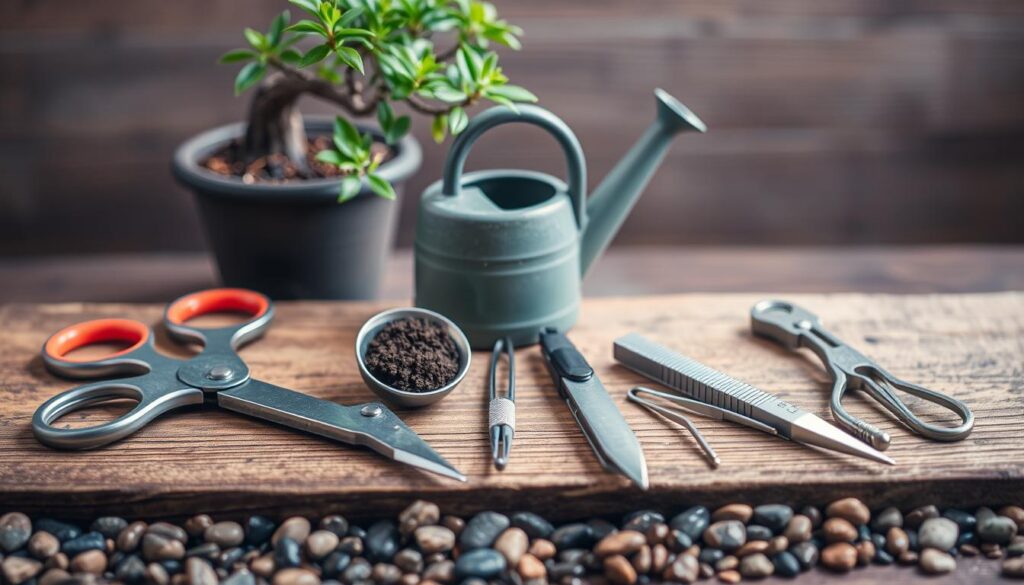
“The true essence of bonsai lies not only in the plant itself, but in the harmonious interplay between the container, the soil, and the tools used to shape its growth.”
Selecting the Perfect Succulent Species for Bonsai
Choosing the right succulent species is key to creating beautiful bonsai art. With over 10,000 types to pick from, there’s a lot to explore. The Jade (Portulacaria) and Desert rose (Adenium) are top picks for beginners. They’re easy to care for and very hardy.
Popular Succulent Varieties for Bonsai Training
- Jade (Crassula ovata): Known for its woody stems and small leaves, Jade is a great choice for bonsai.
- Elephant Bush (Portulacaria afra): This succulent is drought-tolerant and has a unique shape, perfect for bonsai.
- Euphorbia species: Some Euphorbia types, like the Euphorbia trigona, have interesting shapes and textures for bonsai.
Growth Patterns and Characteristics
When picking succulents for bonsai, think about their natural growth and traits. Look for slow-growing types with small leaves and woody stems. These are easier to shape and prune without growing too fast.
Climate Compatibility Factors
Succulents are great for indoor spaces in cooler areas. But they also do well outside in sunny spots. Make sure the species you choose can handle your local climate. Bonsai succulents shouldn’t get too cold, below 40°F (5°C). The Jade Bonsai, for example, is more forgiving with water than other succulents.
By picking succulents based on their growth, traits, and climate needs, you can make beautiful indoor bonsai gardens. These gardens will last a long time and bring joy to your space.
The Basic Growing Requirements
Bonsai tree succulents need the right growing conditions to thrive. They do well in well-draining soil, moderate watering, and bright, indirect light. The ideal temperature range is between 60-75°F (15-24°C). They also prefer low to moderate humidity.
Regular fertilization is key for healthy growth and vibrant leaves. Experts suggest using a balanced liquid feed every two weeks. Also, repotting every 2 years helps prevent the plants from becoming too tight in their pots.
| Bonsai Tree Succulent Care Requirements | Ideal Conditions |
|---|---|
| Soil Type | Well-draining, with a bonsai compost mix of 2 parts peat-substitute potting compost, 2 parts sharp sand, and 1 part John Innes No 3. |
| Watering | Moderate, with the potential for daily watering during summer due to the restricted water capacity of the container. Rainwater is ideal to prevent mineral buildup. |
| Lighting | Bright, indirect light. Sub-tropical bonsai trees may require high humidity levels when grown indoors. |
| Temperature | 60-75°F (15-24°C) |
| Fertilization | Balanced liquid feed at a low dose once every two weeks during the growing season, after an initial slow-release fertilization. |
| Repotting | Every 2 years to prevent the plant from becoming pot-bound and ensure long-term health. |
By meeting these basic needs, you can create a vibrant indoor garden. These plants add a touch of greenery to your home. With proper care, they will bring joy for many years.
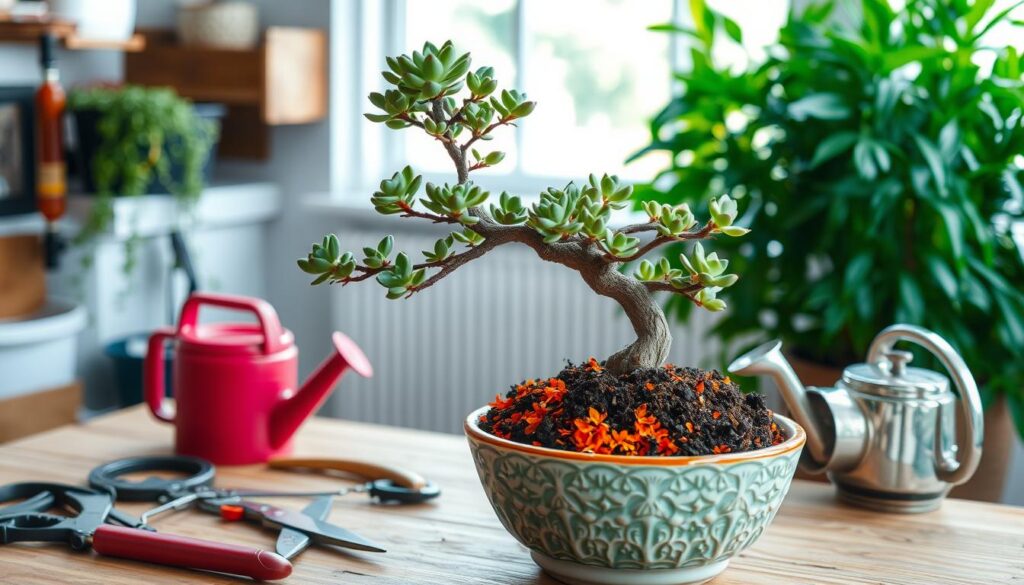
“Bonsai trees are a testament to the beauty that can arise from careful, patient cultivation. By attending to their basic growing needs, we unlock the potential for these miniature wonders to flourish indoors.”
Proper Soil Mixture and Potting Techniques
Starting a bonsai tree succulent garden means knowing the right soil mix. You need a mix that drains well and is full of nutrients. A mix of regular potting soil, coarse sand, and perlite or pumice in equal parts is perfect. This mix is the foundation for your bonsai care journey.
Soil Composition Guidelines
The soil mix is key for your bonsai tree succulents’ health and growth. Akadama, a porous clay soil, is often used. It should make up 30% to 60% of the mix for most conifers. Deciduous species do well with 50% to 80% akadama.
Tropical bonsai plants need a mix with 30% to 50% akadama, plus pumice or lava rock. Broadleaf evergreen bonsai trees need a mix similar to deciduous ones. But, some species like coast redwoods and azaleas might need more akadama or special mixes. The mix must drain well, hold nutrients, and keep moisture right for your indoor gardening bonsai collection.
Container Selection and Preparation
Choosing the right container is as important as the soil. Pick a shallow pot with good drainage holes that fits your plant’s size and style. When planting, spread the roots out and place the plant at the right height and angle. This way, you’ll have a beautiful bonsai tree succulent for your potted plant hobbyists to enjoy.
Watering and Humidity Management
Keeping the right amount of moisture is key for bonsai tree succulents. Let the soil dry a bit before watering again, usually every 7-10 days. This can change based on the weather, season, and plant size. Use the soak-and-dry method to water, making sure water drains from the pot’s bottom.
It’s important to keep humidity low to moderate to avoid rot and fungus. You can use a humidity tray, mist the foliage often, or place the plant in a humid spot. This could be near a kitchen or bathroom sink.
| Watering Frequency | Soil Composition | Humidity Levels |
|---|---|---|
| Every 7-10 days, adjusted based on climate, season, and plant size | Akadama, pumice, and lava rock in a ½ to ¼ to ¼ mix | Low to moderate, maintained through humidity trays, misting, and placement in humid areas |
By finding the right balance in watering and humidity, your bonsai tree succulent will flourish. It will be a beautiful part of your indoor gardening collection.
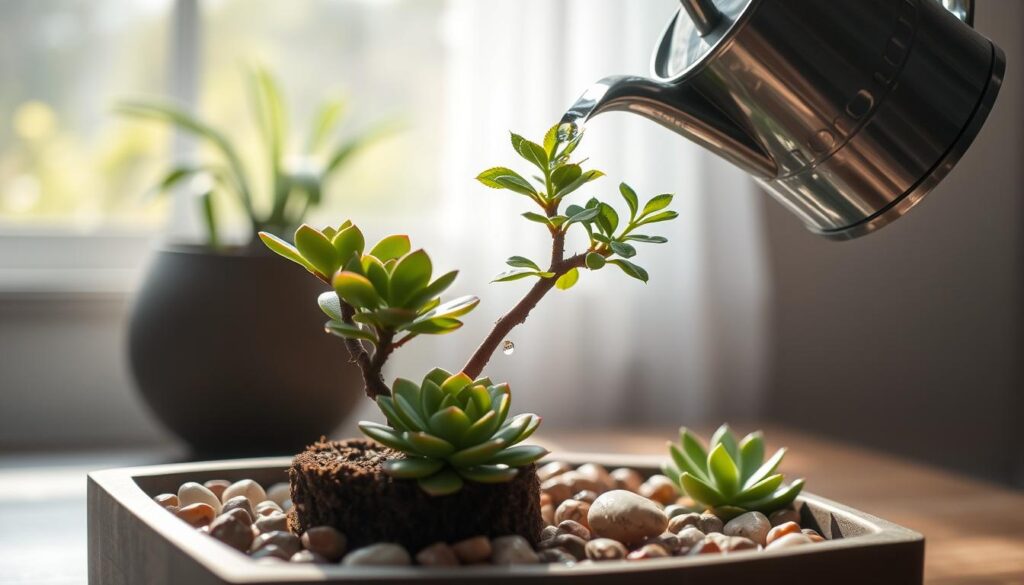
“Proper watering and humidity are the keys to maintaining the health and longevity of your bonsai tree succulent.”
Light Requirements and Positioning
Bonsai tree succulents do well with lots of indoor gardening and low-maintenance greenery. They need bright, indirect light to grow well. Place them near east or west-facing windows for 5-6 hours of sunlight each day.
If it’s not enough, use grow lights to keep your bonsai care up to par.
Rotating your bonsai plant regularly helps it grow evenly. This ensures all sides get enough light. In winter, when days are shorter, move it closer to the light or use lights longer.
Seasonal Light Adjustments
The light needs of bonsai succulents change with the seasons. In summer, put it near a bright window or use lights for 6 hours a day. When winter comes, cut down the light time and move it closer to the window.
- Make sure your bonsai succulent gets 5-6 hours of bright, indirect light every day.
- Rotate the plant often to help it grow evenly.
- Change the light it gets with the seasons to match the daylight hours.
- Use grow lights if natural light isn’t enough, especially in winter.
“Good daylight is crucial for the health of a bonsai, suggesting a need for positioning the tree in well-lit areas.”
By following these tips, you can make a great spot for your bonsai tree succulent to grow and flourish in your indoor garden.
Pruning and Shaping Techniques
Maintaining the intricate bonsai form in succulent plants needs a delicate touch. Thoughtful pruning techniques are key. As tiny tree growing enthusiasts, understanding the art of shaping is crucial. These unique indoor gardening treasures deserve our care.
Start with clean, sharp scissors or concave pruning shears made for bonsai care. Remove excess growth carefully, keeping the succulent’s shape in mind. Pinching new shoots helps with branching and a neat look.
Use aluminum or copper wire to guide branches for the right shape. But be careful not to harm the plant. Raffia can also help bend thicker branches.
Prune at the right time for best results. Shape in early spring or late autumn when the plant is dormant. For upkeep, prune throughout the year, focusing on the growing season. A healthy bonsai can handle losing up to one-third of its leaves.
Patience and a keen eye are essential for bonsai care. With practice, you can create stunning miniature masterpieces. These embody the essence of the tiny tree growing art.
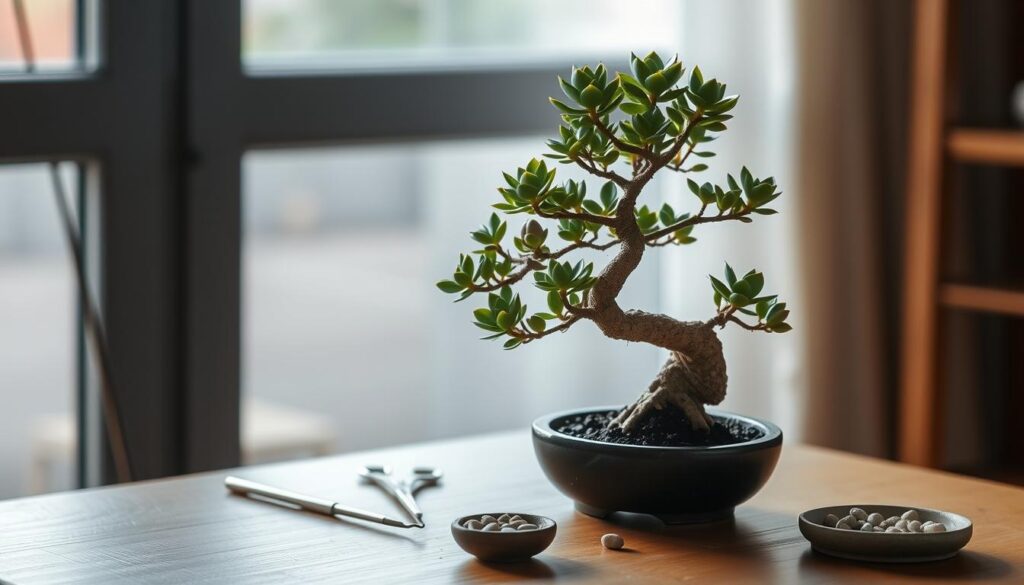
After pruning, make sure to care for your bonsai succulent. Provide thorough watering and apply wound sealant on big cuts. With the right techniques and a steady hand, your bonsai tree succulents will become remarkable living sculptures. They will thrive in your indoor space.
Common Challenges and Solutions
Keeping bonsai tree succulents healthy can be tricky, but it’s doable with the right approach. These plants are great for indoor spaces because they need less care. Knowing how to handle pests and diseases is key to keeping your bonsai alive and well.
Pest Management
Pests like aphids, spider mites, mealybugs, and weevils can harm your bonsai. They can damage the leaves and harm the plant’s health. It’s important to spot and treat pests quickly to avoid more damage.
Look for signs of pests, such as damaged leaves or sticky leaves. If you find pests, isolate the plant and use an organic insecticide or neem oil. Regular checks and quick action can keep your bonsai healthy.
Disease Prevention
Fungal diseases can harm bonsai tree succulents, especially if they don’t have the right care. Problems like root rot, Black Spot, and nutrient deficiencies can cause yellow leaves, wilting, or color changes.
To avoid these issues, make sure the soil drains well, water consistently, and give your bonsai enough light. Use a good bonsai-specific fertilizer to keep nutrients balanced. If a disease shows up, treat it with a fungicide or change the plant’s environment to help it recover.
By being proactive and addressing problems early, you can enjoy your bonsai tree succulents for a long time. With proper care, these plants can be a beautiful part of your indoor gardening space for years.
Seasonal Care and Maintenance Schedule
Proper bonsai care means adjusting your gardening routine with the seasons. Knowing the unique needs of your bonsai tree succulents all year ensures they stay healthy and grow well.
In spring and summer, water more often and use a balanced indoor gardening fertilizer monthly. This supports their active growth. When it gets cooler in fall and winter, water less and stop fertilizing. This lets them rest.
Give your bonsai more light in winter since days are shorter. Prune and shape more in the growing season. Also, repot every 2-3 years in early spring before new growth starts.
- Winter Dormancy:
- Tropical and semi-tropical bonsai do well indoors with south-facing windows or grow lights.
- Temperate bonsai need protection from frost in a greenhouse, cold frame, or garage.
- Water less because they grow slower.
- Spring Awakening:
- Bonsai start growing again, moving from dormant to open leaf stages.
- Start a regular fertilizer routine in spring to help new growth.
- Prune and wire before new growth is seen.
- Summer Bonsai Care:
- Give deciduous bonsai midday shade to avoid sun damage.
- Water more often because of the heat.
- Consider defoliating early summer for trees with strong growth.
- Autumn Bonsai Care:
- Start planning for winter storage as temperatures get unpredictable.
- Move tropical trees indoors when it gets too cold.
- Water less as they prepare for dormancy.
By paying attention to your bonsai care, indoor gardening, and drought-tolerant plants needs seasonally, you can keep your bonsai tree succulents healthy and thriving.
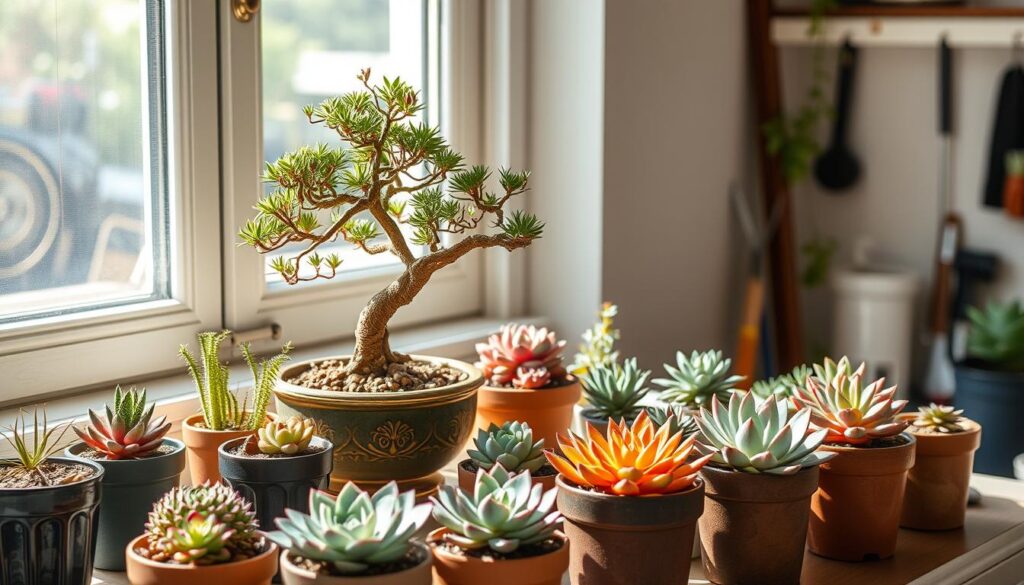
Styling Inspiration and Design Ideas
Bonsai tree succulents open up a world of styling options. They let indoor gardening fans and potted plant lovers show off their creativity. You can shape them into classic formal upright styles or the eye-catching cascade design. These small plants can be molded to highlight their unique growth patterns.
The slanting style, where the trunk leans, offers a natural look. Grouping plants in a forest style is also popular. It lets you create a lush, woodland feel in your home.
To make your bonsai tree succulents more appealing, add decorations like rocks, moss, or tiny figurines. These small touches can turn your bonsai setup into a beautiful, nature-inspired scene.
Try out different container shapes and materials to match your succulent’s natural growth. Whether you choose sleek, modern pots or rustic, earthy ones, the right container can make your bonsai look even better.
“The essence of Bonsai is to appreciate the beauty of nature in miniature.”
Getting into bonsai tree succulents brings nature’s peace and beauty into your home. By trying out various styling methods and design elements, you can add a unique and stunning piece to your indoor gardening, miniature plants, and potted plant hobbyist decor.
Propagation Methods and Growth Development
Starting a bonsai tree succulent is a rewarding journey. Learning how to propagate is key. You can grow from seed or use cuttings, each with its own benefits for indoor gardening and succulent lovers.
Leaf Cutting Techniques
Leaf cuttings are a simple way to propagate bonsai tree succulents. Just take a healthy leaf, let the cut heal for a few days, and then plant it in soil. With care, the leaf will grow roots and a new plant will start.
Offset Division Methods
Offset division is another good method. Separate small plantlets from the main plant and replant them. This way, you can quickly grow more plants, as offsets can quickly become mature bonsai trees.
Choosing the right propagation method is important. Make sure the environment is right and care for the new plants well. Watch for new growth and shape the plants early to get the bonsai look you want.
| Propagation Method | Advantages | Challenges |
|---|---|---|
| Leaf Cuttings |
|
|
| Offset Division |
|
|
Choosing a propagation method is just the start. Growing a bonsai tree succulent is rewarding and teaches you a lot. Enjoy the journey and the joy of watching your bonsai grow.
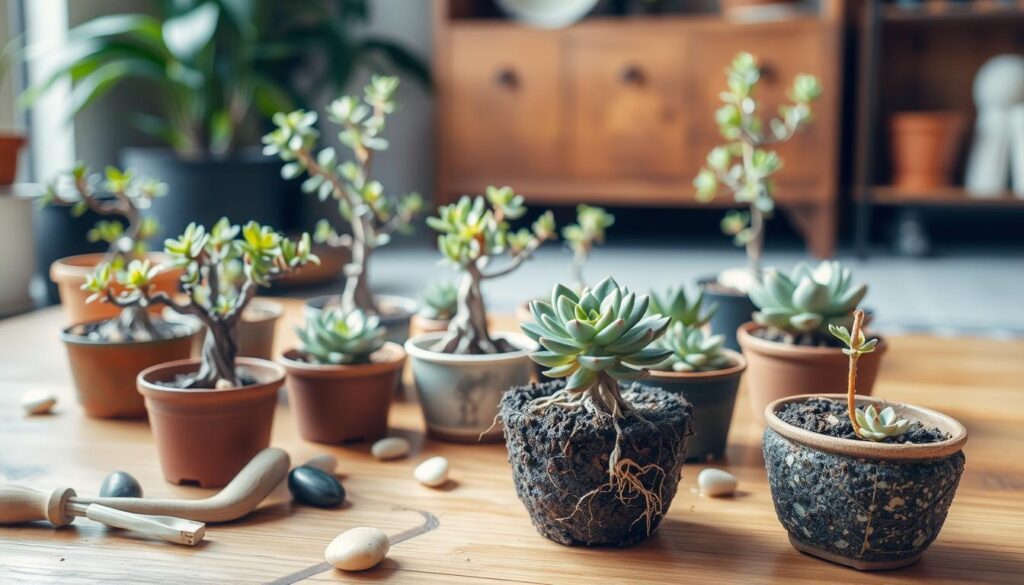
Conclusion
Bonsai tree succulents mix ancient art with modern indoor gardening. They are small, beautiful, and easy to care for. This makes them perfect for those who love plants and want to add nature to their homes.
These plants have detailed shapes, bright colors, and are very hardy. They let gardeners enjoy these tiny masterpieces from their own homes. Whether you’re new to bonsai or gardening, learning about bonsai tree succulents is a fun and rewarding journey.
As you grow your bonsai tree succulents, remember to be patient and pay attention to details. Appreciate the beauty of these small plants. With the right care and techniques, you can make amazing indoor gardens. Your home will become a peaceful place filled with miniature plants and art.
